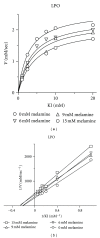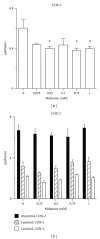Inhibition of heme peroxidases by melamine
- PMID: 22852071
- PMCID: PMC3407616
- DOI: 10.1155/2012/416062
Inhibition of heme peroxidases by melamine
Abstract
In 2008 melamine-contaminated infant formula and dairy products in China led to over 50,000 hospitalizations of children due to renal injuries. In North America during 2007 and in Asia during 2004, melamine-contaminated pet food products resulted in numerous pet deaths due to renal failure. Animal studies have confirmed the potent renal toxicity of melamine combined with cyanuric acid. We showed previously that the solubility of melamine cyanurate is low at physiologic pH and ionic strength, provoking us to speculate how toxic levels of these compounds could be transported through the circulation without crystallizing until passing into the renal filtrate. We hypothesized that melamine might be sequestered by heme proteins, which could interfere with heme enzyme activity. Four heme peroxidase enzymes were selected for study: horseradish peroxidase (HRP), lactoperoxidase (LPO), and cyclooxygenase-1 and -2 (COX-1 and -2). Melamine exhibited noncompetitive inhibition of HRP (K(i) 9.5 ± 0.7 mM), and LPO showed a mixed model of inhibition (K(i) 14.5 ± 4.7 mM). The inhibition of HRP and LPO was confirmed using a chemiluminescent peroxidase assay. Melamine also exhibited COX-1 inhibition, but inhibition of COX-2 was not detected. Thus, our results demonstrate that melamine inhibits the activity of three heme peroxidases.
Figures






Similar articles
-
Identification and characterization of toxicity of contaminants in pet food leading to an outbreak of renal toxicity in cats and dogs.Toxicol Sci. 2008 Nov;106(1):251-62. doi: 10.1093/toxsci/kfn160. Epub 2008 Aug 9. Toxicol Sci. 2008. PMID: 18689873
-
Role of heme-protein covalent bonds in mammalian peroxidases. Protection of the heme by a single engineered heme-protein link in horseradish peroxidase.J Biol Chem. 2006 Jul 14;281(28):18983-8. doi: 10.1074/jbc.M602307200. Epub 2006 May 1. J Biol Chem. 2006. PMID: 16651262
-
Spectral analysis of lactoperoxidase. Evidence for a common heme in mammalian peroxidases.J Biol Chem. 1996 Feb 16;271(7):3406-12. doi: 10.1074/jbc.271.7.3406. J Biol Chem. 1996. PMID: 8631940
-
Recent advances in the risk assessment of melamine and cyanuric acid in animal feed.Toxicol Appl Pharmacol. 2013 Aug 1;270(3):218-29. doi: 10.1016/j.taap.2012.01.012. Epub 2012 Jan 25. Toxicol Appl Pharmacol. 2013. PMID: 22306862 Review.
-
Melamine toxicity.J Med Toxicol. 2010 Mar;6(1):50-5. doi: 10.1007/s13181-010-0038-1. J Med Toxicol. 2010. PMID: 20195812 Free PMC article. Review.
Cited by
-
Effect of Concomitant Hydroxyurea Therapy with Rutin and Gallic Acid: Integration of Pharmacokinetic and Pharmacodynamic Approaches.ACS Omega. 2021 May 25;6(22):14542-14550. doi: 10.1021/acsomega.1c01518. eCollection 2021 Jun 8. ACS Omega. 2021. PMID: 34124477 Free PMC article.
-
Lactoperoxidase: structural insights into the function,ligand binding and inhibition.Int J Biochem Mol Biol. 2013 Sep 13;4(3):108-28. Int J Biochem Mol Biol. 2013. PMID: 24049667 Free PMC article. Review.
References
-
- Melamine Contaminated Pet Foods—2007 Recall List. US FDA; 2008.
-
- Yhee JY, Brown CA, Yu CH, Kim JH, Poppenga R, Sur JH. Brief communication: retrospective study of melamine/cyanuric acid-induced renal failure in dogs in Korea between 2003 and 2004. Veterinary Pathology. 2009;46(2):348–354. - PubMed
-
- Brown CA, Jeong KS, Poppenga RH, et al. Outbreaks of renal failure associated with melamine and cyanuric acid in dogs and cats in 2004 and 2007. Journal of Veterinary Diagnostic Investigation. 2007;19(5):525–531. - PubMed
-
- Langman CB. Melamine, powdered milk, and nephrolithiasis in Chinese infants. The New England Journal of Medicine. 2009;360(11):1139–1141. - PubMed
-
- Bhalla V, Grimm PC, Chertow GM, Pao AC. Melamine nephrotoxicity: an emerging epidemic in an era of globalization. Kidney International. 2009;75(8):774–779. - PubMed
LinkOut - more resources
Full Text Sources
Other Literature Sources
Research Materials

